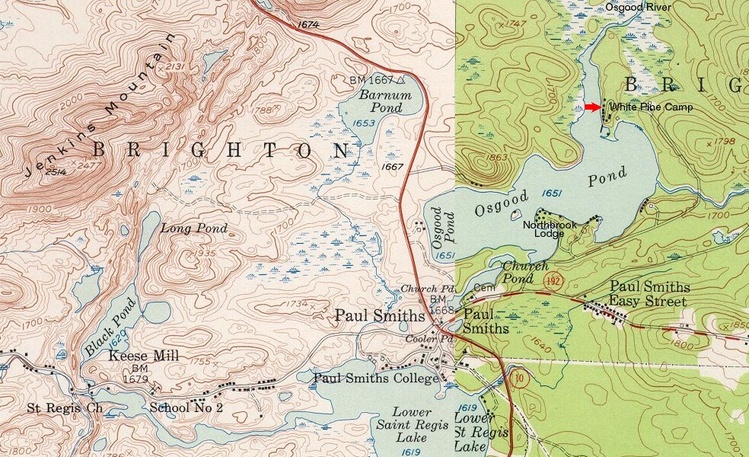 1955 USGS Map of the Paul Smiths Area. White Pine Camp is at upper right.
1955 USGS Map of the Paul Smiths Area. White Pine Camp is at upper right. 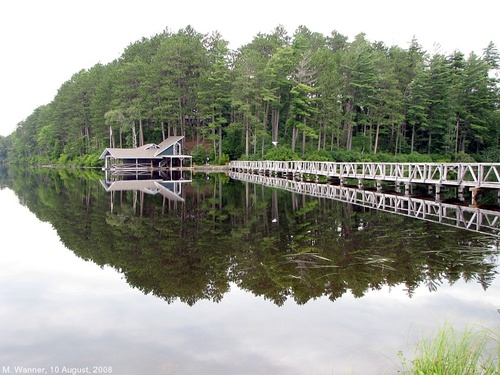 Boat House
Boat House 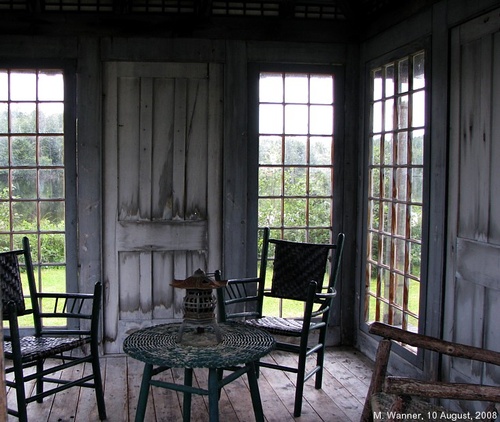 The Japanese Tea House interior
The Japanese Tea House interior 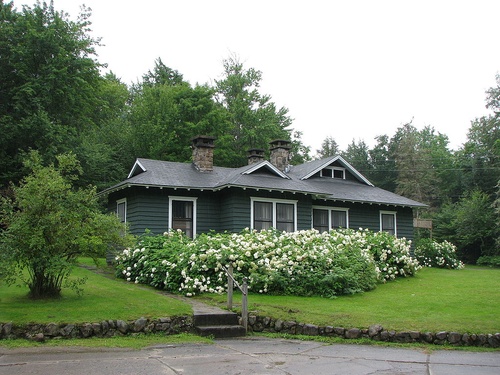 The Gate House, built about 1916
The Gate House, built about 1916 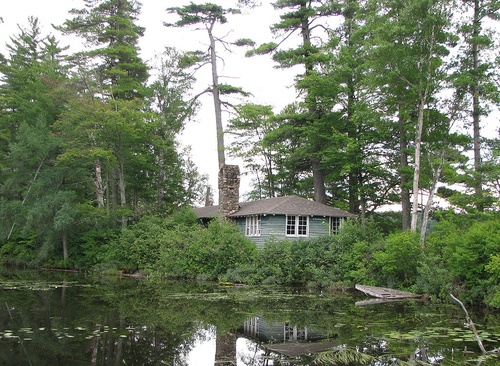 The Bowling Alley (built 1911)
The Bowling Alley (built 1911) 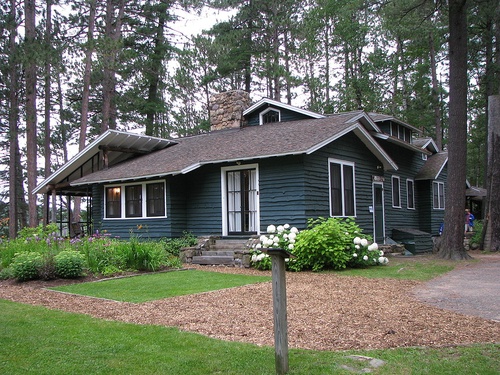 The Owners Cottage - Occupied by President and Mrs. Coolidge in 1926
The Owners Cottage - Occupied by President and Mrs. Coolidge in 1926  The 'Great Room' or dining room and kitchen building (1907-08)
The 'Great Room' or dining room and kitchen building (1907-08) 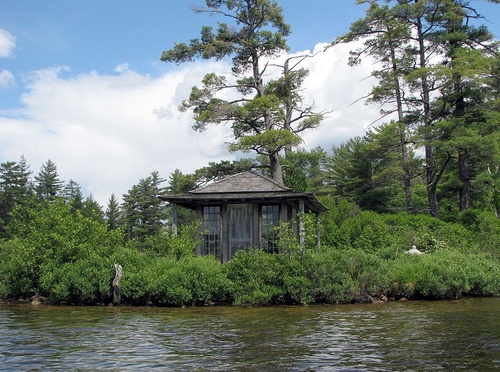 The Japanese Tea House White Pine Camp is an Adirondack Great Camp on Osgood Pond near Paul Smiths. It served as the Summer White House for US President Calvin Coolidge from July 7 through September 18, 1926.
The Japanese Tea House White Pine Camp is an Adirondack Great Camp on Osgood Pond near Paul Smiths. It served as the Summer White House for US President Calvin Coolidge from July 7 through September 18, 1926.
The camp was built for New York businessman Archibald White in the early 1920s on 35 acres that he leased from Paul Smith starting in 1907; it consists of 20 buildings, including the owner's cabin, a dining hall, four sleeping cabins, two boathouses, an indoor tennis house and bowling alleys, and a Japanese teahouse. The large living room building burned down during Paul Smith's College ownership; its footprint can be seen in the center of the camp.
The camp was designed by architect William Massarene and built by local master builder Benjamin A. Muncil. It was later expanded by architect Addison Mizner, well known for his work in Florida.
The camp was later owned by Adele Levy and Edith Sterns, daughters of the president of Sears-Roebuck; they donated it to Paul Smiths College, which used it for student housing for the next 35 years.
In 2003, the property was sold to a group interested in historic preservation called White Pine Camp Associates LLC headed by Howie Kirschenbaum; they operate the property as a museum and guest cottage.
In June 2020 a fast-moving fire destroyed the camp's service complex, parts of which had been renovated into rental cabins. Everyone escaped safely and the principal buildings were undamaged. See the Adirondack Daily Enterprise for photos and details.
Malone Farmer, July 19, 1911
The way some city people entertain in the Adirondacks is strikingly illustrated by the following from an Adirondack exchange: "One of the largest house parties ever assembled in an Adirondack camp is now at the Osgood Lake place of Archibald S. White, of New York, where Miss Helen White, his daughter, is hostess.
Some fifty guests are present and on Tuesday evening a play was given in the new theatre, the Hermit's Hut which Benjamin A. Muncil, the contractor at Paul Smiths, completed especially for the occasion. The plumbing in the building was installed by Paul Amnot, of the firm of Amnot & Donohue, while P. H. Ryan of the Adirondack Greenhouses shipped a carload of blooming plants to be used in camp decoration for the occasion. Miss White brought her guests up to Paul Smiths in two private Pullmans, accompanied by a colored orchestra and troop of actors, who furnished the entertainment Tuesday evening."
Tupper Lake Herald and Adirondack Mountain Press, June 5, 1930
NEW YORK STATE NEWS
...White Pine Camp on Osgood Lake which in 1926 was the summer White House occupied by President and Mrs. Coolidge, has been leased for this summer by Edgar B. Stem of New Orleans, a leader in banking circles in the south. Accompanied by his family and a large staff of servants he will reach camp the latter part of June and remain for the summer.
Adirondack Daily Enterprise, September 23, 1948
Grant To Benefit Forestry School Of Area College
PAUL SMITHS, Sept. 23 — Paul Smith's College has received a grant from the children of the late Julius Rosenwald. The property included in the grant is to be made avail:ble to the School of Forestry immediately.
White Pine Camp, once the Summer White House for President Calvin Coolidge, was built some 35 years go by Archibald and Olive Moore White. It was then owned by Mr. and Mrs. Irwin R. Kirkwood and has belonged to the present owners since 1930.
Mr. and Mrs. Edgar B. Stern of New Orleans, Louisiana, and Dr. and Mrs. David M. Levy of New York city, co-owners, today announced that they have turned the entire property with most of the furnishings over to the college.
This tract of land is located on Osgood Lake adjoining other Paul Smith property and only three miles from the other school buildings. The camp is composed of 25 buildings and is one of the most beautiful and well kept camps in the Adirondacks.
The buildings consist of a very large living room, dining room, kitchen, refrigeration plant, houses, apartments, cottages, boat houses, garages and bowling alley. There are other recreational facilities such as tennis courts and a trap-shooting field.
An attractive feature is the large number of stone fireplaces, all of original design and no two alike. The camp, together with its large amount of furnishings and equipment, will make an important addition to Paul Smith's College.
Plans have been made to have the Forestry School start using this property at once. Students as well as some faculty and staff will be housed there. This is the second important development in the Forestry Department at Paul Smiths this summer. Recently tile U. S. Forest Service established a Forest Experiment Station at Paul Smiths. It has been set up on a 2,200 acre tract of college land and is known as the Paul Smiths Experimental Forest.
The Racquette [of SUNY Potsdam], September 25, 1950
White Pine Camp Ends Second Year
White Pine Camp, the summer camp operated by Potsdam State Teachers College, has completed its second season. The summer session opened with registration on July 2, and the six weeks session ended August 11.
White Pine Camp is located in the center of the Adirondacks and it is here that Potsdam State Teachers College conducts a summer program of the study of the arts. The session is conducted on a workshop basis and stresses the integration of the arts as well as the development of creative activity. The creative activity is designed in itself to be enriching and satisfying. Courses that were offered included painting, music, literature, and the stage arts, including drama and the modern dance.
The members of the faculty were selected for their first class acquaintance with the various arts and also their ability to develop creative potentialities of others. The registration at White Pine Camp is limited to sixty-five students to enable the faculty to give individual attention to the students. The instructional staff had as its members Merrill Bailey, Art Department; Stanley Glowacki, English; Eleanor Kunitz, English; Stanley Kunitz, English; and Bessie Schonberg, Director of Dance.
As a seminar project, the students at White Pine Camp presented a dramatic production, entitled "The Life of Man" written by Leonid Andreyev, "The Life of Man" was a direct outgrowth of the activities at the camp. The students in the Drama Workshop group directed the scenes, members of the dance workshop did the choreography, and those members, of the Music Workshop with Richard Pisano composed and performed an original musical score. The acting version of Andeyev's play was edited by the workshop in Creative Writing and was especially prepared to enable the utilization of the arts as an expressive theatrical medium.
Another special activity which increased student interest in the art forms was the publication of the WHITE PINE PIPER; the newspaper published by the students of the camp. These and many other activities went into making White Pine Camp's second season a most successful one.
Adirondack Daily Enterprise, June 17, 1995
Restoring Coolidge's summer White House
By ANDY FLYNN
Enterprise Staff Writer
PAUL SMITHS - The North Country has had its share of famous visitors in the past two centuries. Abolitionist John Brown had a farm in North Elba. Theodore Roosevelt became president while riding on a buckboard to North Creek in the middle of the night. And Calvin Coolidge almost cracked a smile near Paul Smiths.
White Pine Camp on Osgood Pond was the site of Coolidge's 1926 summer White House. 2
The camp buildings are undergoing a complete restoration, according to Dr. Howard Kirschenbaum, White Pine Camp director and president of Adirondack Architectural Heritage.
"We're restoring as accurately as possible," Kirschenbaum said.
He and his crew want to create a 1926 feel to the White Pine Camp experience, and they're using old photographs as a guide while reconstructing the property. The work so far has included replacing the roofing and rebuilding rotted floors, walls, and railings around the camp. Although the museum is slated to open on July 1, restoration won't be complete for about two more years, according to Kirschenbaum.
White Pine Camp sits on 35 acres and has 3,900 feet of shoreline on Osgood Pond. There are 20 buildings on site. The property includes: A bowling alley, two boathouses, a pump house, a dining room/kitchen house, a Japanese tea house on an island, a master's bedroom cottage, four guest cottages, a tennis-watching house, a tennis tea house, an icehouse, and servant living quarters. The property also offers a 300-foot bridge across a lagoon, an English clay tennis court, and great quantities of rhododendrons.
White Pine Camp was built in 1907 for Archibald White, a banker and businessman from New York City. There were two architects: William Massarene in 1907 and 1908; and Addison Mizner, who came in later and refurbished the place, designing structures such as the tennis tea house.
Ben Muncil was the contractor who built White Pine Camp. He was known as the master camp builder of the area, also credited with the construction of nearby Camp Topridge, the former summer home of heiress Marjorie Merriweather Post.
But White Pine Camp is unique, according to Kirschenbaum.
"There simply is nothing like it," he said.
Muncil and Massarene collaborated to create a complex of asymmetrical frame buildings with soaring roof lines, unusual angles, extensive use of glass in corner windows, skylights, and the first use of wavy-edged "brainstorm" or "Adirondack" siding. The combination of rustic and pre-modern elements is not found anywhere else in the Adirondack Great Camps, according to Kirschenbaum.
"It was a pre-modern architecture style," he said. "It's not what you expect when you think of a Great Camp."
When Coolidge stayed at White Pine Camp, it was owned by Irvin Kirkwood, the wealthy publisher of the Kansas City Star newspaper. He turned the premises over to the presidential party for the summer of 1926.
Mr. and Mrs. Coolidge arrived at the Gabriels railroad station from Washington, D.C. on July 7, 1926. They rode the final five mile leg of the trip in a car. At the camp gate, the president was saluted by 53 U.S. Marines who were to stand guard during his stay in the Adirondacks.
For 10 weeks, the nation's business was conducted from Paul Smiths as Coolidge played host to senators, ambassadors, cabinet members, and other prominent Americans.
Coolidge also was a frequent visitor to Saranac Lake that summer. He attended services at the Presbyterian Church each Sunday.
Soon after the limelight faded from White Pine Camp, the property was bought by the Stern and Levy families, the daughters of Sears, Roebuck President Julius Rosenwald. They owned the complex from 1930 until they donated the camp to Paul Smith's College in 1948.
College officials turned the summer White House into a student dormitory. The dorm, however, presented a transportation problem because it's about two miles from the main campus. And so in 1983, college officials sold the complex.
Some of the buildings fell into disrepair. Others, like the guest cottages were modernized. Originally, each of them was complete with a bedroom, a fireplace, a bathroom, and a dressing closet.
Now they have stoves, sinks, and refrigerators.
"A couple of modern kitchens is the only inconsistency right now," Kirschenbaum said about the restoration.
Exhibits on property will include one on White Pine Camp history and architecture, and another on the Adirondack Great Camps. Guided tours will also be available.
New York Times, July 21, 1912
DESPERATE COACH HOLD-UP.
Bandits of Varied Patterns Capture Archibald White's Guests.
Special to The New York Times.
SARANAC LAKE, N. Y., July 20.—To entertain his guests on the Fourth of July, Archibald S. White of New York brought down to date the flavor of an Adirondack coach hold-up. A Concord coach, conveying twenty-five guests of Mr. White from Paul Smiths to his camp on Osgood Lake, was held up by masked men and Indians on Saturday morning. Mr. White had provided the old coach to give his guests a taste of life as it was in the mountains before the railroads. With John Ryan driving the four white horses, the old Concord was on hand upon the arrival of the New York train which reaches Paul Station in the morning. Several of Mr. White's guests who were already in camp came to Paul Smiths to accompany the newcomers to Osgood Lake.
John Ryan started the horses up with the flourish of old coaching days. There was laughter and a blare from the yard-ot-brass as the Concord rolled out. The road to White Pine camp winds through the forest. The-track is sandy and the coach toiled slowly camp ward.
When about three miles of the distance had been covered the driver saw the form of a man in the road. The man was lying down. He did not move. Ryan fastened the reins and climbed down from the top of the coach to see what the trouble was.
When the driver was about to bend over the man suddenly: got up and covered Ryan with a pistol. At the same instant about fifteen masked men and Indians sprang whooping into the road from the woods, and with a volley of shots from guns and pistols, called upon every man and woman passenger to stand and deliver.
John Ryan looked into the barrel of the pistol pointed at him.
"I thought," said John afterward, "that I would take chances with that feller and that pistol. There were a mighty lot of pretty women on top of that coach, and I did hate most awful to see 'em molested. But I looked at the pistol a second time and heard the shooting and yelling on all sides, and came to the conclusion that I had better do about as I was told. He tied my hands and went after the rest."
The bandits were the most ferocious crew ever seen off the stage and scandalously wasteful of their powder. They were living patterns of Western plain and mountain pass hold-up men from every outlaw district on the globe. Mixed with the outfit were several painted savages. Even the coach shook with fright.
The hands of the men were tied above their heads. Their pockets were emptied of all valuables.
Suddenly one of the young women swung her fingers into the long gray whiskers of a robust bandit who was going through her purse. The whiskers came off.
"Archibald White!" she screamed. It was none other.
About the same moment a copper-faced Indian left some of his complexion upon the sleeve of a pretty girl. She recognized a young man of hitherto unblemished reputation.
"I planned the hold-up," said Mr. White later, "as a novelty for my house party. It was very successful. I did not make the mistake that some real bandits made some years ago. They held up a coach load on their way home from a Summer spent at Paul Smiths. Of course the bandits found nothing. I planned my holdup better. I stuck up the coach load on their way in, when their pocketbooks would be well filled."
Count Johann Heinrich von Bernstorff, German Ambassador to the U.S., was a guest at White Pine Camp in 1914. The scandal that took him down — a newspaper photo of him with two young ladies, neither one his wife, in bathing costumes — apparently occurred here, though he reportedly also visited Camp Wild Air on Upper St. Regis Lake.
Mildred Phelps Stokes Hooker, Camp Chronicles (Blue Mountain Lake, NY: Adirondack Museum, 1964), page 4.
At the time of the First World War there was a camp owner on Osgood who was supposed to be more intimate than she should have been with Count von Bernstorff when he was German ambassador. Rumors were rife about secret meetings and hidden wires and messages to Germany. She owed Phelps Smith a good deal of money, and being pressed to pay, at last agreed to give him a cheque if he wouldn't cash it until later. The cheque was cashed the next day, and the irate debtor arrived in high dudgeon at the hotel. "How could you!" she stormed. "We had a gentleman's agreement about that cheque!" "Well, now," said Phelps, "I never did claim to be no gentleman and I never supposed you were no lady."
Adirondack Daily Enterprise, June 30, 2018, reprint of the Enterprise in 1987
Coolidge came to the camp three days after his birthday, arriving at the Gabriels train station on July 7, 1926.
Calvin Coolidge was an avid fisherman and he planned to take full advantage of the opportunities at his doorstep. Both bass and pike were available in Osgood Pond, and he enjoyed a standing invitation from William Rockefeller to fish the trout streams coursing his private park at nearby Bay Pond. Orman Doty of Rainbow Lake and Oscar Otis, who was Kirkwood's caretaker, served as guides on the fishing expeditions. The two local men agreed that Coolidge was not only a good fisherman but a kind and considerate companion as well.
Quite naturally the fishing had to be constantly interrupted by national affairs.
External links:
- Adirondack Architectural Heritage - White Pine Camp
- Two Camps on Osgood Pond, Lee Manchester
- ''Time'', "At White Pine Camp", August 30, 1926
- "International Newsreel" footage of Coolidge at White Pine Camp
Comments
Footnotes
1. This article appeared originally on "Wikipedia" as White Pine Camp; its edit history there reflects its authorship. It is licensed under the GDFL.
2. The article originally contained the sentences "And now the camp is to become a museum. Members of Adirondack Architectural Heritage, a non-profit historic preservation organization, bought White Pine Camp this year and currently are transforming the property's buildings into a museum." They subsequently ran a correction reading "Adirondack Architectural Heritage had nothing to do with the purchase of the White Pine Camp property or the project." However, Howie Kirschenbaum, was AARCH's founding board president, and other AARCH members were involved in the project. And White Pine Camp has subsequently been operated as a resort.



